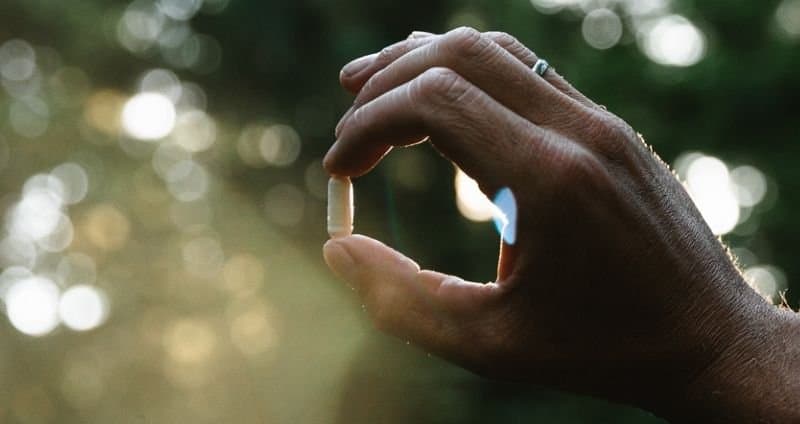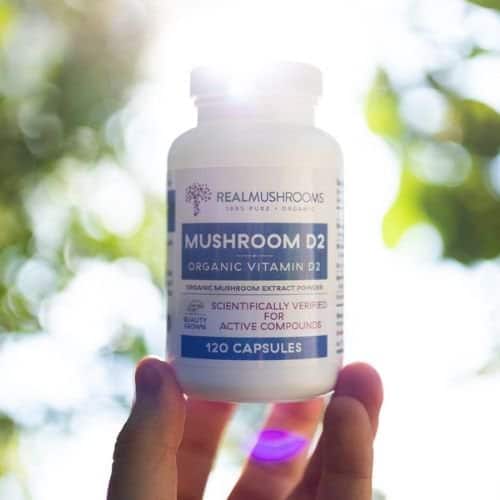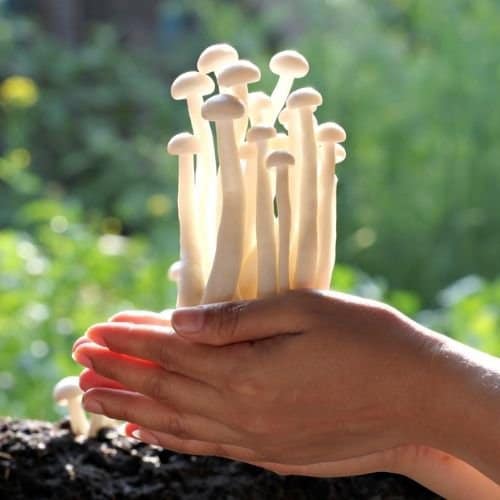Menu


Did you know most sources of supplemental vitamin D come from lanolin, a wax found in sheep’s wool?
If you follow a plant-based diet, this might be something you want to avoid. To solve this dilemma, Real Mushrooms has created a vegan vitamin D out of, yup, you guessed it: Mushrooms.
In this guide, we will explain in depth how the human body processes sunlight into vitamin D and uses it to maintain its functions.
We’ll also analyze which populations have vitamin D deficiency issues, why supplementation is of utmost importance, and finally, we will talk about how to find the best plant-based source of vegan vitamin D to optimize your health.
Note: The information in this article has been reviewed by Dr. Mason Bresett, Naturopathic Doctor. Chief Science Advisor for Real Mushrooms.

The human body requires many nutrients to run optimally every single day, including vitamin D. Some of these nutrients the body can miraculously produce on its own (non-essential), and others need to be obtained from the diet (essential).
Essential nutrients cannot be synthesized by the body and, therefore, must be supplied from foods.
Vitamin D is a fat-soluble vitamin that helps your body absorb calcium and phosphorus. It appears in small quantities in a few foods, such as:
Although vitamin D can be obtained in various foods, it is generally needed as a supplement, especially for those living in less sunny regions.
As the name suggests, vitamin D deficiency is the body’s lack of vitamin D. This can be due to a lack of sun exposure or not having enough vitamin D in one's diet.
Vitamin D deficiency can result in symptoms such as:
During winter, the Northern Hemisphere leans away from the sun, there are fewer daylight hours, and the sun hits us at an angle, making it appear lower in the sky. This also means the sun's rays hitting the earth are not as strong.
Since we get most of our vitamin D from the sun, most North Americans who experience the winter season are at risk of deficiency in vitamin D. This is because they don’t have sufficient sun exposure to get the necessary amount of vitamin D from UV rays (ultraviolet radiation).

It’s amazing how the human body can translate sunlight into energy.
Here’s how it works: ultraviolet light stimulates the production of cholecalciferol (a vitamin D precursor), which the body absorbs from the skin and eventually transforms into active vitamin D3.
Vitamin D obtained from sun exposure, food, and supplements is inactive when first present in the body, so it must undergo two chemical processes to activate.
The first occurs in the liver and converts vitamin D to 25-hydroxyvitamin D [25(OH)D], also known as calcidiol. The second occurs primarily in the kidney and forms the physiologically active 1,25-dihydroxyvitamin D [1,25(OH)2D], also known as calcitriol [1].
Both vitamin D2 and D3 are formed through ultraviolet exposure of precursors: ergosterol for D2 and 7-dehydrocholesterol for D3.
It’s true that most forms of D3 are animal-based. The available non-animal forms (yeast, edible mushrooms) are based on the fungus kingdom and are primarily D2 [2].
Alternative Vitamin D3 Sources: There is lichen-based D3 derived from an edible lichen (a complex life form made from a fungus and alga).
There has been some debate on whether vitamin D3 is more effective than D2 [7]. The two variants have traditionally been regarded as equivalent based on their ability to cure rickets (a skeletal disorder caused by a lack of vitamin D, calcium, or phosphate).
Most steps involved in the metabolism and actions of vitamin D2 and vitamin D3 are identical. Both forms can raise serum 25(OH)D levels [1].
Vitamin D expert, medical doctor, author, and researcher Dr. Michael Holick, uses a synthetic Vitamin D2 form in his clinic and his data suggests it is as efficient as Vitamin D3 [7]. He did mention that you need to obtain a good quality source and proper dosage.
While some past research publications suggested that D2 intake may decrease the construction of Vitamin D3 [4], Dr Holick maintains that these studies dismantle the future use of Vitamin D2 for therapeutic purposes without substantiated evidence.
He has conducted his own research around Vitamin D, performing three studies on Vitamin D2 and Vitamin D status. He confirmed that the kidneys are able to convert Vitamin D2 to the active form of Vitamin D [7].
Rest assured that you can supplement your natural vitamin D from an environmentally friendly and humane option: commonly consumed mushrooms! This is great news for vegans as the mysterious and miraculous mushroom comes to save the day yet again!
Not everyone can easily get fresh mushrooms to help them reach adequate vitamin D levels.
Then again, even store-bought shiitake mushrooms bought from grocery stores can have questionable quality. This is why most people get more than their adequate amount of vitamin D from dietary supplements.
Most of the vitamin D dietary supplements in the market are sold to us in its D3 form, and it’s primarily made from irradiating sheep lanolin (a wax secreted by the sebaceous glands of wool-bearing animals). This may seem unattractive to some vegans out there who do not consume or use animal products.
It also begs the following questions:
It’s important to question everything and to trace back to the source of your food and supplements. Quality and sourcing are everything when it comes to the health of your body, mind, and spirit.
Recent work from the Vitamin D, Skin, and Bone Research Laboratory at Boston University Medical Center evaluated a newer food source of Vitamin D: mushrooms exposed to UVB light, which provide a significant source of D2.
In this study, it was determined that healthy adults who ingested 2000 IUs of Vitamin D2 from mushrooms daily for three months were able to raise and maintain their total 25(OH)D concentrations. These are similar figures to healthy adults who ingested supplements containing either 2000 IU of Vitamin D2 or D3.
This study suggests that both Vitamin D2 and D3 are equally able to help consumers meet their body’s vitamin D needs.
About 1 billion people worldwide have a Vitamin D deficiency or insufficiency [5]. We understand the urgency of getting people's bodies back up to healthy levels; that’s why we’re thrilled to bring you vegan vitamin D made purely from the highest-quality mushrooms.
While many “mushroom” products sold on the market are just myceliated grain and do not contain any actual mushroom (fruiting body), our mushroom extracts are free from grains and fillers, and we use the whole mushroom, which contains many compounds such as beta-glucan (a polysaccharide found in the cell wall of mushrooms).

Our whole-food, plant-based source of vitamin D uses 100% organic Agaricus and shiitake mushroom for our capsules, each containing 1000 IU of vitamin D2. We recommend taking one capsule per day over a prolonged period of time.
For people aged 9-70, adequate intake is 600 IU/day, while the maximum safe upper level of intake is at 4,000 IU/day [3].
Becoming informed about the contents and sources of any health supplement you are considering purchasing is crucial to getting effective health support.
Learn more about how to spot fungi supplements that contain grain fillers and little to no mushrooms at all, by reading our article about mushrooms versus mycelium.

Ultraviolet light exposure during the growing phase is essential for getting vitamin D from mushrooms. This is an important point that many articles touting mushrooms for vitamin D leave out. Without UV light exposure, most mushrooms have almost no vitamin D.
For example, the common button mushroom has roughly 7 IU of vitamin D per 100 grams, which is relatively low. But mushrooms have this incredible ability to absorb sunlight and convert it into vitamin D2.
Small amounts of Vitamin D2 are found in wild mushrooms [2]. However, D2 levels can be amplified with ultraviolet light exposure.
Ergosterol (which is a fungal sterol similar to cholesterol in humans) needs to be converted into ergocalciferol (D2), and this is done by exposing cultivated mushrooms to UV light.
One study showed that vitamin D2 levels can be increased in various mushrooms by exposing them to pulsed UV light.
With each additional pulse, the mushrooms were exposed to increasing amounts of ultraviolet radiation. Thus, more energy is available for Vitamin D2 synthesis. Not all mushrooms deliver the same results, as oyster and shiitake mushrooms showed higher amounts of vitamin D2 content compared to other mushrooms after pulsed UV light exposure [6].

Raise Vitamin D Levels: You can enhance how much vitamin D content is in fresh mushrooms by just putting them out in the sun for 20 minutes!
Taking mushroom extracts will help us sustain how much Vitamin D2 are in our bodies. In general, mushroom benefits for health are numerous, so we also want to highlight other supportive compounds your body will receive as a bonus!
Besides supplementing your body’s need for adequate vitamin D content, the great thing about functional mushrooms is that they are amazing allies for your immune system. The common threads between all varieties are their ability to support immunity and promote a healthy inflammation response.
The cell wall of the mushroom (fruiting body) contains beta-glucans. These wonderful compounds can increase host immune defense by enhancing macrophage and natural killer cell function [9]. Beta-glucans also mediate inflammation in the body by helping to regulate various inflammatory cytokines [8].
Mushrooms For Wellness: To go deeper into the power of fungi for overall wellness, check out our article about the 7 medicinal mushroom benefits for health.

We’re truly on the precipice of global change; each one of us has the ability to make decisions that will greatly impact our health and the earth. Our vegan vitamin D supplement made from 100% organic mushrooms will surely make your cells dance in celebration; after all, humans have evolved alongside fungi for thousands of years!
Be sure to try our vegan vitamin D or our vegan D2Z vitamin D supplement with zinc, and let us know your thoughts! We’d love to hear from you and how it made you feel.
We use only 100% organic mushrooms (fruiting bodies), so rest assured that no grain or fillers end up in your supplement. Real Mushrooms’ products have the purest and most potent concentrations of mushrooms, so order our dietary supplements today!
Disclaimer: The information or products mentioned in this article are provided as information resources only, and are not to be used or relied on to diagnose, treat, cure, or prevent any disease. This information does not create any patient-doctor relationship, and should not be used as a substitute for professional diagnosis and treatment. The information is intended for health care professionals only. The statements made in this article have not been evaluated by the Food and Drug Administration. Any products mentioned are not intended to diagnose, treat, cure, or prevent any disease. The information in this article is intended for educational purposes. The information is not intended to replace medical advice offered by licensed medical physicians. Please consult your doctor or health practitioner for any medical advice.